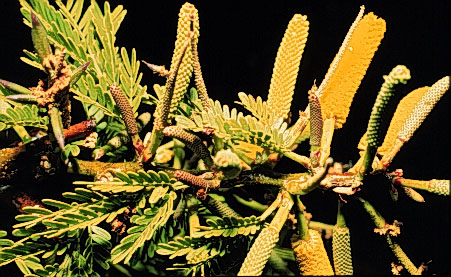
Acacia collinsii Saff.
Cornizuelo
(Fabaceae)
|
Acacia collinsii Saff. Cornizuelo (Fabaceae) | |
Masís, A., Chavarría, F., Guadamuz, A., Perez, D. and Espinoza, R. 1998. Acacia collinsii (Fabaceae) Species Page, April 1, 1998. Species Home Pages, Area de Conservación Guanacaste, Costa Rica. http://www.acguanacaste.ac.cr
I. Identification:
Shrub up to 5 m tall.
Flower:
Axillary spike, light yellow. Perfect flower.
|
View of the inflorescence | |
Inflorescence in detail | |
Fruit:
Dehiscent sheath containing seeds enwrapped in yellow aril which becomes exposed upon the opening of the sheath.
Longitudinal cut of the fruit |
Seeds |
Leaves:
Bipinnate. Dark green on the upper surface and light green on the under surface. Grooved petiole. There are glands (2-3 united) at the base of the petiole.
|
Under and upper sufaces |
|
Nectaries |
Bark and wood:
There are hollow thorns in the form of horns covering the trunk and all of the branches.
The bark has a fine reticulate pattern and is grey.
|
View of the thorns and the trunk |
Whole plant architecture:
|
View of the plant |
Similar species:
Acacia cornigera has indehiscent pink fruits in the shape of banannas, 12 cm long.
Verification:
Synonym: Acacia nicaraguensis, Acacia costaricensis,
II. Geographic distribution:
International:
In Costa Rica
In the Area de Conservación Guanacaste:
Map of macro-habitats of the
ACG |
III. Natural History:
Acacia collinsii is an example of coevolution between insects and plants, with ants of the species Pseudomyrmex ferruginea living in the hollow thorns. They provide protection for the plant and the plant provides food (Beltian Bodies at the tips of the young leaves and nectar from the nectaries).
The fruit (the pulp) is food for bats and birds such as the urraca (Calocita formosa).
Acacia collinsii is indigenous to the ACG while cornigera is indigenous to Palo Verde, mainly on the edge of the wet lands.
The fundamental difference between these two species is that Acacia collinsii is dehiscent while cornigera is indehiscent and looks like a pink bananna 12 cm long with a sweet flavor. Cattle eat it like they do the fruit of Acacia farnesiana and in the wild, birds can open them to remove the pulp and seeds, while collinsii is fed upon more by bats and other birds such as urracas that eat the pulp of the open fruit. When I (commentary Daniel Janzen) arrived here all of the individuals of cornigera were associated with areas with houses. Now I don't see them anymore. I suppose the older individuals died and weren't reproducing.
Other species in the country are located north of Dominical and on the Osa Peninsula. Acacia allenii, and Acacia rudii, species with very large leaves, and thin errect, black thorns are possibly located in Pitilla in areas similar to the Pizote river. In a given node there can only be 0 or 1 spines. The spines have holes produced in them when they are green by a miner caterpillar of the moth. The ants are not obligatory to these species, but if they do have species of Pseudomyrmex that live in the hollow branches the ants arrive after the caterpillars and clean it in order to use it, because of this the hole can not be found in the same place as the thorns that have obilgatory ants. Other possilbe species that can be found are Acacia hindsii, in the central vally of the Santa Ana zone, with thick spines at the flat base. Species range from Mazatlan to Guatemala.
The Pseudomyrmex (ants) associated to the acacias are belti (black), nigrocinctus (yellow), and ferruginea (red).
It has various synonyms A. castaricensis, A. nicaraguensis, A. hondurensis and others due to the different zones there is a wide variety in the form of the thorns.
The adults of Calinda bicuspis (Juanpalo) feed on these plants (Janzen 1998, Pers. Com).
IV. How to find:
They are very common along edge of the highway to the Santa Rosa sector.
Acknowledgements.
This project was carried out by the Area de Conservación Guanacaste/CR, with help from INBio/CR, ICBG from the Foggarty center, NIH/USA and NSF/USA.
Thanks to Kate Beattie and Alexandra Kern for helping with the image management and the translation of this species page.
Literature cited: